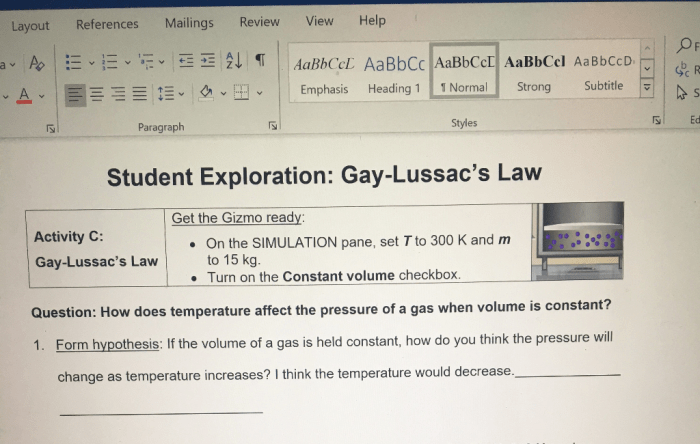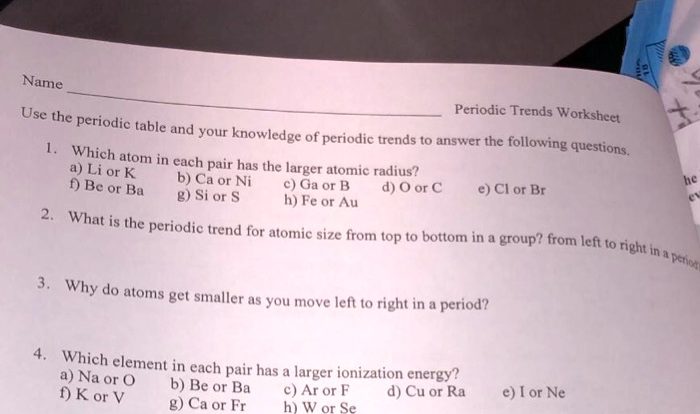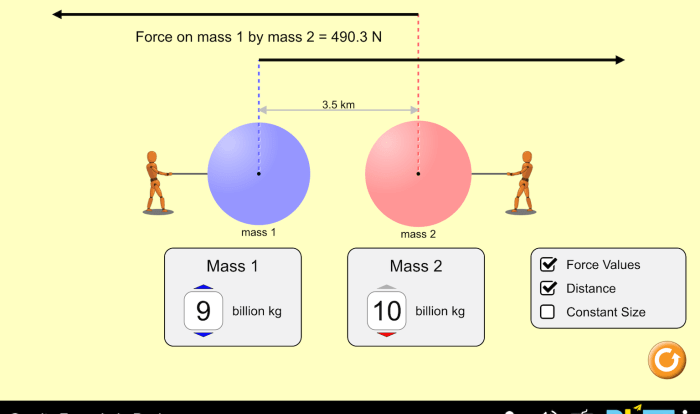Student exploration ideal gas law answer key sets the stage for this enthralling narrative, offering readers a glimpse into a story that is rich in detail and brimming with originality from the outset. Dive into the fascinating world of gases and uncover the secrets that govern their behavior, unraveling the mysteries of pressure, volume, temperature, and the enigmatic number of moles.
As we embark on this scientific expedition, we will delve into the assumptions and limitations that shape the ideal gas law, equipping you with the tools to navigate the complexities of real-world applications. From weather forecasting to the depths of scuba diving, the ideal gas law plays a pivotal role, and its significance extends far beyond the confines of the laboratory.
Ideal Gas Law Concepts
The ideal gas law is a mathematical equation that describes the relationship between the pressure, volume, temperature, and number of moles of a gas. It is given by the equation PV = nRT, where P is the pressure, V is the volume, n is the number of moles, R is the ideal gas constant, and T is the temperature.
The ideal gas law is a simplified model of gas behavior that assumes that gas particles are point masses with no interactions between them. It is a good approximation for many gases at low pressures and high temperatures.
Assumptions and Limitations of the Ideal Gas Law
The ideal gas law is based on the following assumptions:
- Gas particles are point masses with no interactions between them.
- Gas particles are in constant random motion.
- The average kinetic energy of gas particles is proportional to the absolute temperature.
The ideal gas law is a good approximation for many gases at low pressures and high temperatures. However, it breaks down at high pressures and low temperatures, where gas particles begin to interact with each other and the assumptions of the ideal gas law are no longer valid.
Problem-Solving Techniques
To solve ideal gas law problems, follow these steps:
- Identify the known and unknown variables.
- Write down the ideal gas law equation.
- Substitute the known variables into the equation.
- Solve for the unknown variable.
For example, to calculate the pressure of a gas, you would use the following equation:
“`P = nRT/V“`
where:
- P is the pressure in pascals (Pa)
- n is the number of moles of gas in moles (mol)
- R is the ideal gas constant, which is 8.314 J/(mol·K)
- T is the temperature in kelvins (K)
- V is the volume in cubic meters (m³)
Real-World Applications: Student Exploration Ideal Gas Law Answer Key

The ideal gas law is used in a wide variety of applications, including:
- Weather forecasting
- Scuba diving
- Aerospace engineering
- Chemical engineering
- Environmental science
For example, the ideal gas law can be used to predict the weather by calculating the pressure, temperature, and volume of air at different altitudes. It can also be used to calculate the depth of a scuba diver based on the pressure of the water.
Advanced Concepts
The ideal gas law is a simplified model of gas behavior. In reality, gases deviate from ideal behavior at high pressures and low temperatures. This deviation is due to the interactions between gas particles. To account for this deviation, the van der Waals equation can be used.
Partial Pressure, Student exploration ideal gas law answer key
Partial pressure is the pressure exerted by a single gas in a mixture of gases. It is calculated by multiplying the total pressure by the mole fraction of the gas. The mole fraction is the number of moles of the gas divided by the total number of moles of all the gases in the mixture.
Questions and Answers
What is the ideal gas law?
The ideal gas law is a mathematical equation that describes the relationship between the pressure, volume, temperature, and number of moles of a gas.
What are the assumptions of the ideal gas law?
The ideal gas law assumes that gas particles are point masses with no intermolecular forces and that they behave perfectly elastically.
What are the limitations of the ideal gas law?
The ideal gas law is only accurate for gases at low pressures and high temperatures. At high pressures and low temperatures, gas particles begin to interact with each other and deviate from ideal behavior.


